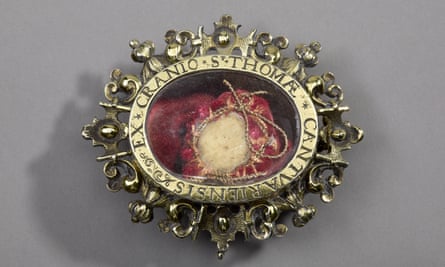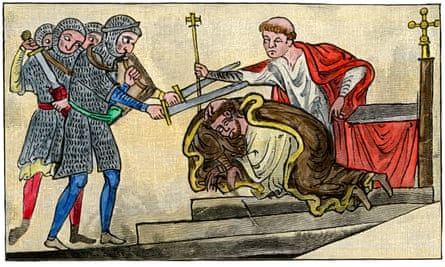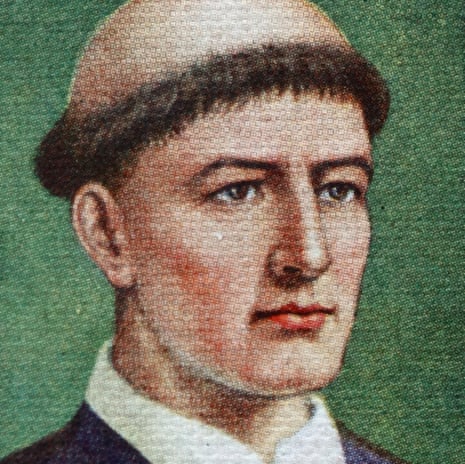For centuries it was the world’s most notorious state-sanctioned murder. When King Henry II of England made it clear in the winter of 1170 that his dislike of the cleric Thomas Becket had reached new levels, it took just a few days for four of his knights to go into action, hewing down Becket, the archbishop of Canterbury, inside his cathedral.
Now, in the first major exhibition about Becket, the murder, and the cult that rose up following his death, the British Museum is to display a wide range of the surviving objects from the crime scene. Among them, as a gory crowning glory, will be a surviving fragment of the martyr’s skull.
“It is kept, as a precious relic, at Stonyhurst College, the Catholic school in Lancashire, and we have been talking to them for some years about this,” said curator Lloyd de Beer. “It will be the final exhibit in the show – a last moment of connection with the real man at the heart of the story.”
The killing on 29 December 1170 shocked the medieval world. In the book that de Beer and his co-curator, Naomi Speakman, have written to accompany the exhibition, Thomas Becket: Murder and the Making of a Saint, they make it clear the crime was one of the most well-documented events of the era, since it was witnessed by a cathedral congregation. All the same, the sheer cruelty and violence of the act has been forgotten.

“Becket was actually in his palace when the knights arrived in Canterbury,” Speakman said.
“Becket was a real hothead, and he more or less said ‘come and get me’ to them, even gesturing with the side of his hand that they should slice into his neck.”
When the archbishop went into the cathedral, the knights donned full armour, with helmets that left only their eyes visible. “With this display of martial power, they followed him into the darkness at the centre of the cathedral at about 4pm. There were monks praying and townspeople gathered, and they asked where Becket the traitor was. He replied: ‘I am here and I’m no traitor to the king. I am a priest.’ ”
The attack that followed, on an unarmed religious man in such a holy place, shocked eyewitnesses, five of whom wrote accounts of it, and then shocked the world. One heroic man, Edward Grim, is said to have put out his arm against a sword blow but the strength of the thrust almost severed his arm. The sword fell, shattering on the flagstones.
The killing finished with blows to Becket’s head that splashed the floor with blood and brains. Pieces of the knights’ swords and the martyr’s skull became venerated relics.
“It is amazing that ours will be the first major exhibition to tell Becket’s story, when you consider how long he has been an important figure across Europe and the object of an enduring religious cult,” said Speakman.
But one element of the infamous story still needs correcting. Henry II’s imperious question, “Who will rid me of this meddlesome priest?” (or troublesome priest, or turbulent priest – take your pick), is well known. But scholarship has established that it is unlikely to be what the king actually said that day at his Christmas court in Normandy. “We do debunk that myth, but it was a handy way to get across how angry the king had been,” said Speakman. “He probably used much stronger language. We do think he talked about ‘miserable drones’ and described Becket as a ‘lowborn clerk’.”

Becket had already been exiled once, in France for six years, but his challenges to the authority of the monarchy over the church continued.
Much like Thomas Cromwell nearly four centuries later, Becket had enjoyed a spectacular rise to power. De Beer sees a clear comparison between the two self-made men.
“In some ways, he was a kind of 12th-century version of Cromwell in that he had this stratospheric trajectory into the king’s court but was then seen as traitorous. And at the heart of the story is this violent murder in Canterbury Cathedral, which came to be seen as one of the holiest places in Europe afterwards. It put it on the world map as a key site of pilgrimage, along with Rome, Jerusalem and Santiago de Compostela.”
Speakman adds that while Becket lay on the ground that day simply as “a dead archbishop”, he was then placed on the high altar, before being interred in the crypt and becoming an object of veneration, a martyr and a saint. Pilgrims travelled to Canterbury to drink his blood, supposedly collected from the flagstones, and countless miracles of healing were observed.
“They drank from these extraordinary, intricately decorated tin alloy flasks, which we have on show,” said de Beer. Also on display will be one of the stained-glass “miracle windows” made in 1200 to surround his tomb in the cathedral.
Kings and queens, including the young Henry VIII, visited the tomb in the centuries that followed, but Becket became the focus of royal violence once again in 1530 when Henry decided to break with Rome and the authority of the pope over his plan to divorce and remarry. During the Reformation that followed, he ordered all symbols of the old religion to be destroyed, and veneration of Becket, as a rebellious critic of a previous monarch, was particularly censured.
“In September 1538, the shrine was destroyed by royal agents, who stripped the gold and pulled out all the gems,” said Speakman. “The pink marble shrine was completely smashed up.”
The question of what happened to Becket’s bones has been a mystery, tackled in a succession of studies, but the fragment of skull now to go on show was smuggled out of the country – itself a dangerous act of treason.
This article was amended on 29 April 2021 to change references to “worship” in relation to Becket to “veneration”.
Thomas Becket: Murder and the Making of a Saint runs from 20 May to 22 August in the Joseph Hotung Great Court Gallery at the British Museum
